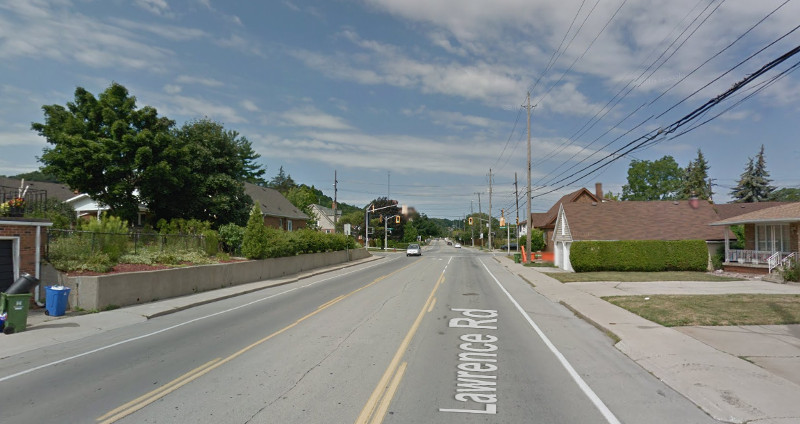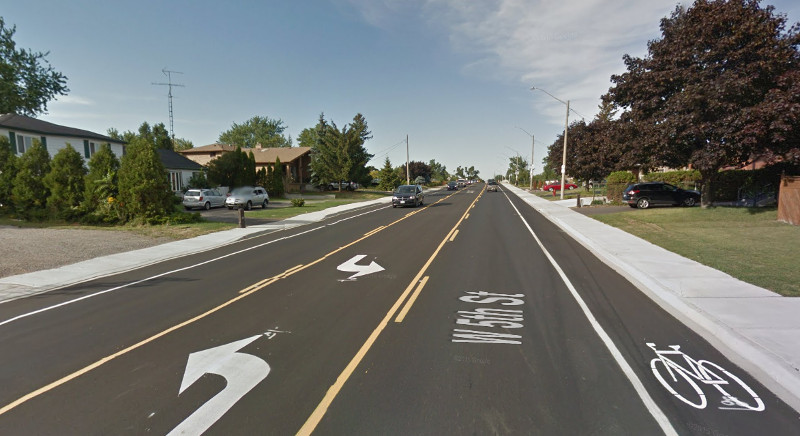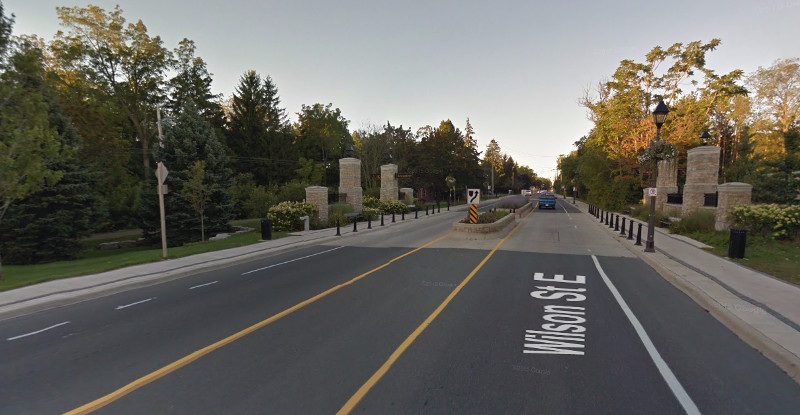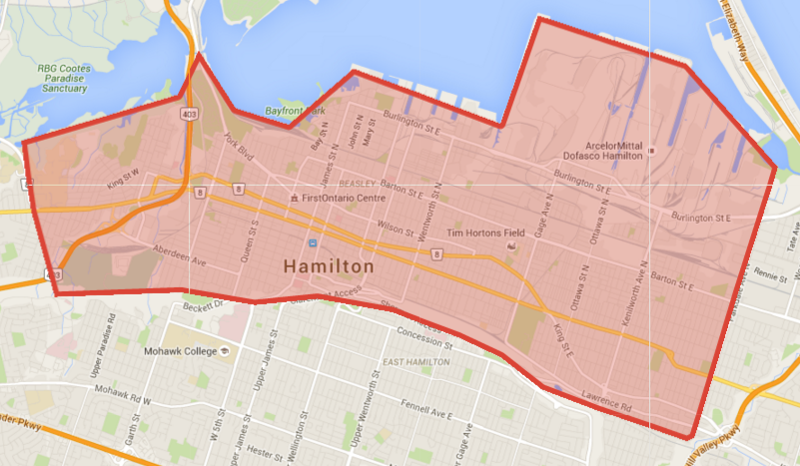This war on the lower city comes from the ugly political tradition of stoking contempt to manufacture a phony crisis and score cheap points at the expense of the city's overall well-being.
By Ryan McGreal
Published November 30, 2015
Kevin Love has written a thoughtful article making a case for turning Aberdeen Avenue into a safe local residential street by eliminating dangerous cut-through traffic. This is, of course, exactly what cities in The Netherlands have been doing for the past four decades, and it has succeeded in making them safe havens for walking and cycling.
If Hamilton was a truly progressive city, this is what we would be doing. When you stop to think about it, it's actually quite astonishing that you can drive between the West Mountain and West Hamilton faster on residential surface streets than you can on the ring highway system that was specifically built for commuting.
That in itself indicates how far out of order our priorities are: in Hamilton, we think absolutely nothing of deforming an entirely residential neighbourhood street into a four-lane thoroughfare that consists almost entirely of fast, dangerous cut-through traffic rather than local traffic.
But what Love has proposed is not what Ward 1 Councillor Aidan Johnson and the Kirkendall Neighbourhood Association have proposed. Instead, they have put forward a very modest compromise that accepts the continued presence of cut-through traffic but merely asks for a little bit of the excess roadway space to be repurposed to make local use safer and more inclusive.
In a more normal city, what Love describes would be the controversial initial proposal and what is actually being proposed might be the ultimate solution brokered with the suburban voting interests that bridges the various competing demands on the street.
Instead, we live in a city where even a modest compromise that was specifically designed to continue allowing cut-through traffic is rejected so vehemently, so hyperbolically, that it actually provoked a Mountain councillor to propose a moratorium on any changes to the entire lower city street system to make it safer or more inclusive.
Folks, it is truly insane that such a response has even been proposed by someone whose job it is to lead the city, let alone that anyone is taking it seriously.
The people living around Aberdeen Avenue, a designated minor arterial, are not asking to eliminate cut-through traffic. They are not asking for their neighbourhood to become a walled garden.
They are only asking for a slightly better balance between the current regime of roaring traffic and the needs of local residents to get around safely.
They are asking for Aberdeen to be balanced like, say, Lawrence Road in the east end, which is also a minor arterial that connects to our ring highway system:

Lawrence Road (Image Credit: Google Street View)
They are asking for Aberdeen to be balanced like, say, Stone Church Road on the south mountain, a crosstown minor arterial in a very suburban part of the city that still manages to function with one lane in each direction and dedicated bike lanes:

Stone Church Road (Image Credit: Google Street View)
They are asking for Aberdeen to be balanced like, say, West 5th Street, a minor arterial on the West Mountain - the very ward of the councillor who has declared open war on street safety improvements across the entire city:

West 5th Street (Image Credit: Google Street View)
They are asking for Aberdeen to be balanced like, say, Wilson Street in Ancaster, a major arterial whose complete street redesign was celebrated by its local Councillor:

Wilson Street, Ancaster (Image Credit: Google Street View)
We have examples right here in Hamilton of arterial streets that achieve a better balance between uses that we can apply to Aberdeen - and we can implement them for the cost of paint and some staff time! There is really no excuse not to move forward with this.
The opposition to making Aberdeen Avenue safer and more inclusive is not about protecting its role as a cut-through minor arterial, not really. The street carries 18,000 cars a day, which can easily be accommodated on one lane in each direction with left turn lanes.
It requires nothing less than a wholesale rejection of reality and utter contempt for the full weight of a very large, broad body of global evidence to oppose this change that Kirkendall residents have gotten organized to develop and advocate.
Worse, it requires utter contempt for the people living in the lower city - not just around Aberdeen, but within the entire sacrifice zone that has been proposed for a moratorium on street safety improvements.

Proposed area of moratorium on new stret safety improvements (Image Credit: Google Maps)
The excuse that we can't make any streets safer because light rail transit (LRT) is coming is transparently ridiculous. As Nicholas Kevlahan has pointed out, all of the research on LRT indicates that it will be more successful, not less, if we combine it with complete, walkable streets.
No, this proposed moratorium on making our city safer does not come from any serious policy positions. Like far too many council decisions in Hamilton, it comes from a position of contempt and loathing for the lower city.
It comes from the depressingly familiar ugly political tradition of stoking and channelling anti-urban fear and loathing to manufacture a phony crisis and score cheap points at the expense of the city's overall well-being.
It combines the worst impulses of narrow parochialism, chauvinism and knee-jerk opposition to change to incite conflict among people who, when you step back and take a deep breath, mainly want the same things.
Livable streets are a fundamental quality of life issue. No one wants to live on a street roaring with with dangerously fast traffic. Councillors in every single part of the city regularly get resident requests for stop signs, speed humps, bumpouts, police enforcement and other city interventions to reduce dangerous speeding and make their streets calmer, safer and more pleasant.
The Golden Rule of basic fairness insists that you should not impose on others what you would not want imposed on yourself.
We have an easy, cheap and timely opportunity to support civic engagement and add safety and walkability to Aberdeen without taking away the ability for people to use it as a shortcut. In fact, people using the street as a shortcut would also benefit from reduced speeding, making the street safer for everyone.
Cheap, easy, win-win: That's the Holy Trinity of good municipal policy. Beware any politician who tries to deform this into a divisive us-vs-them conflict!
By Downtown zombie (anonymous) | Posted November 30, 2015 at 10:26:10
You nailed it Ryan. Therefore.... Terry's reactionary-ism is the problem, and maybe the solution.
Terry is, mostly, reacting to his constituents, who value commute time over other people's lives.
Terry only needs to listen to them to hang on to his job. We need to engage the un-engagable suburbs. So let's stop holding events at Mills Hardware and start holding them up where people disagree with us.
Grass roots to grass roots conversations will be more productive than grass roots to a stone wall conversation.
By kevlahan (registered) | Posted November 30, 2015 at 10:31:59 in reply to Comment 115232
I guess at this point I need to point out again that just last Wednesday the LRT citizens jury held their first public presentation and Q&A by the director of Calgary Transit on the challenges and opportunities of LRT (including for street and urban design) at Mohawk College, in TW's ward.
And as Ryan highlights in the article, the residents of Kirkendall are just asking for Aberdeen to be re-designed to match the way many similar minor arterials have been re-designed in the suburbs.
It really shouldn't be so controversial!
After all people from Ward 1 need to drive on the mountain all the time (e.g. to get to Limeridge, Meadowlands or their jobs at the suburban business parks), but they don't demand a veto over street design. In fact, I don't remember any real council discussion or public outreach at all on those projects. They were completely uncontroversial.
Comment edited by kevlahan on 2015-11-30 11:38:03
By Attendance (anonymous) | Posted November 30, 2015 at 12:10:47 in reply to Comment 115233
I applaud having the LRT presentation outside the lower City but couldn't attend and have wondered...
How well attended was it and who showed up? Was it mostly locals or lower City regulars who would have been out wherever it was held?
Please let me know. I think we need to do far more to engage people and raise the level of discussion regarding lower City issues across the entire City.
By kevlahan (registered) | Posted November 30, 2015 at 12:46:29 in reply to Comment 115236
Attendance was quite good for this sort of meeting (maybe 40-50, I'm not sure), which was a presentation in a lecture hall. I recognized a few people as "regulars" interested in urban issues, but there were mostly new faces and lots of detailed knowledgeable questions over the two hours of presentation.
The next meeting, on Wednesday, is at the Pat Quinn Arena at Main East and Parkdale. Still lower city, but very far from downtown and close to Stoney Creek and the East Mountain via RHVP.
By Pxtl (registered) - website | Posted November 30, 2015 at 10:42:08
One thing that hasn't seen much discussion is the "ring road" itself. It's no secret that the reason that Garth takes traffic down the escarpment is that the linc is backed up where it ends at the 403. If we're going to add capacity to Hamilton's ring road, this seems like a far more appropriate place to add it than the Linc/Red Hill.
I mean, it should be obvious - the eastbound 403 is 2 lanes. The Linc is 2 lanes. The Red Hill is 2 lanes. Everything is at least 2 lanes... except:

This is backed up every day. 2 lanes of 403 and 2 lanes of Linc become 2 lanes of 403 and 1 lane of Linc, then 2 lanes period.
This is also a reason that widening the Linc will accomplish diddly-squat, just like keeping Aberdeen 4 lanes wide doesn't actually do much for congestion when the congestion is caused by the Queen/Aberdeen intersection.
By KevinLove (registered) | Posted November 30, 2015 at 11:17:37
I would like to think that in a more normal city, the principles of Sustainable Safety would be the default value and the advanced proposal would be to make Aberdeen Street car-free. Like, for example, the Toronto Islands, where demand to live in the car-free zone is so high that people pay $100 to enter a lottery with a less than one-in-ten chance of getting their name on the bottom of a 20-year-long waiting list.
Too bad that people in Hamilton are totally denied choice in housing. A car-free residential neighbourhood is simply not a choice we are allowed to make. Car drivers don’t just cram their lethal poisons down our throats. They impose their lifestyle and their values upon everyone else. With no choice.
It does not have to be this way. Virtually every Dutch city has a car-free downtown. Entire cities from Hamburg to Helsinki are planning to go entirely car-free.
Hamilton? Welcome to the 1970’s.
By Haveacow (registered) | Posted November 30, 2015 at 13:33:41
We use to play a kind of game when I was a kid that was similar to Red Rover but it started with everybody holding hands in a large circle. The point was trying to get the home base in the centre which was surrounded by a smaller ring which was the safe zone. Just outside the safe zone was the person who was "it" and they had to catch people from the outer ring trying to get to the home base. The result was as more people were caught it and they became "it" as well, it became much harder for the remaining people on the outside to get to home base of the larger circle. The last person caught won.
This kind of reminds me of how Hamilton's freeway system ring road functions. Drivers circle the ring road and try to get to their point (their favorite expressway exit) that gives them the shortest path to home. They then make a sort of mad scramble along said path, that gets them home. The difference between the game I described and the actual road system is there is other traffic using the ring road for other kinds of trips or going to other locations outside the ring road. The process then operates in the opposite direction for the other main commuter traffic peak period.
My basic point is that there is a fundamental issue that I have noticed since I started to follow this website. The transportation status quo forces and associated infrastructure, whether it is more expressways or GO Trains, are primarily focused on getting out of or back into from the outside, of the city of Hamilton. The direction of the primary traffic flow changes depending on which peak traffic period is being travelled in. All the new rapid transit and commuter cycling most support on this website are based for traffic moving in and around the City of Hamilton. The forces that are against LRT or better bicycle infrastructure primarily are focused against anything that slows down that first or last mad dash to or away from the city of Hamilton towards or away from the outer circle if you want to you use my child's game analogy. Yes, this is a grand simplification but I believe it still very applicable to the situation.
I offer some advice to people who want to engage the Hamilton suburbanites and others who fear the slowing of traffic by the adding two way streets, improved bicycle infrastructure, road diets and other new measures like LRT that will forever change the city. Its about making your city a destination not a place you pass through on your way to somewhere else. It is about place building not just in the city but in the burbs as well. Changing the current dynamic that has made Hamilton a place, lets be honest, most want to avoid stopping in and go through as quickly as possible. You can't compete with other places and cities economically, if your transportation infrastructure is designed to make it hard for people stop in your community and keep them moving towards the outside of your city as quickly as possible.
Keep in mind, you can't block all movement through your neighborhoods and through movement in and out of the city, in fact you need them to continue to grow both physically and economically. However, you do need to recognize what needs to pass through fast and what doesn't need to pass through fast. Identify these routes and their proper transport modes and build on them but build the links inside the city like LRT that help make the city and your burbs a location to go to not pass through.
Tell your anti urban detractors, outsiders think your suburban locations are just as, if not more forgettable than your downtown. The places that the anti urban supporters want to keep the traffic moving quickly through are the places the outsiders most want to see!
By JasonL (registered) | Posted November 30, 2015 at 18:50:21
looking at those images of slightly more balanced streets in other parts of the city, a couple thoughts come to mind:
By ergopepsi (registered) | Posted November 30, 2015 at 19:23:31
It's frustrating that Councilor Whitehead can attack the lower city with impunity but those of us living here can't express our dissatisfaction with him at the ballot box. Something is really not right here.
I'm worried that other wards will allow this thing to happen. It seems that they pile on us every chance they're given.
By JasonL (registered) | Posted November 30, 2015 at 21:44:42 in reply to Comment 115245
Yep. Hating on downtown is a favourite past-time of the wards who siphon our $ paying for all their roads and cul-de-sacs
By ergopepsi (registered) | Posted December 02, 2015 at 18:34:03
Well at least they are going to look into it. http://www.cbc.ca/news/canada/hamilton/n...
You must be logged in to comment.
There are no upcoming events right now.
Why not post one?